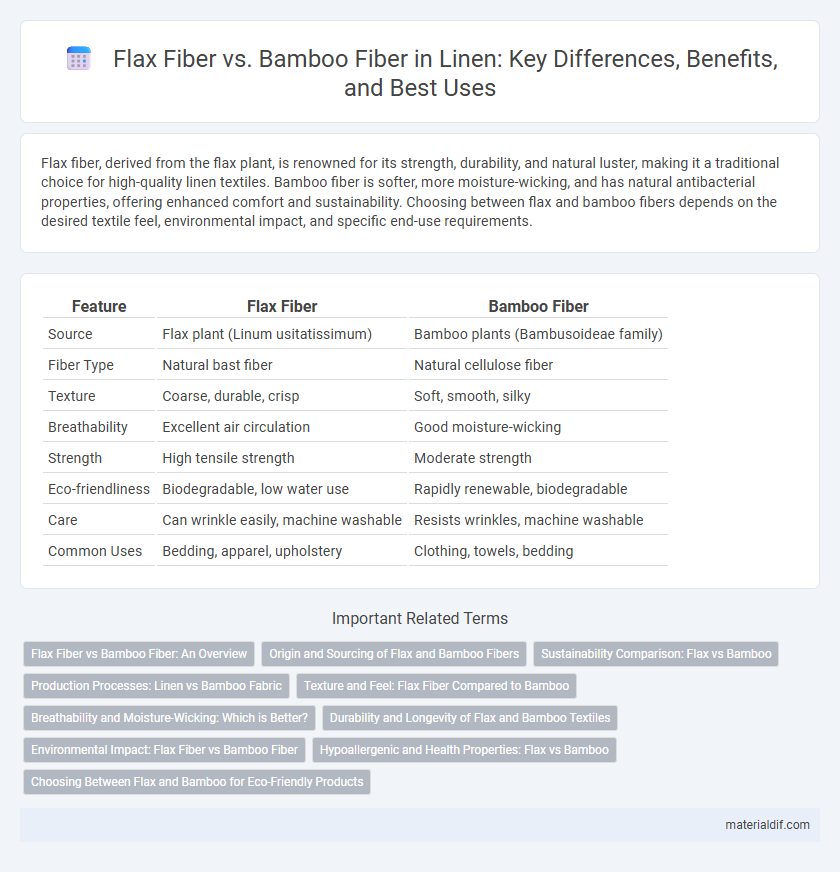Flax fiber, derived from the flax plant, is renowned for its strength, durability, and natural luster, making it a traditional choice for high-quality linen textiles. Bamboo fiber is softer, more moisture-wicking, and has natural antibacterial properties, offering enhanced comfort and sustainability. Choosing between flax and bamboo fibers depends on the desired textile feel, environmental impact, and specific end-use requirements.
Table of Comparison
| Feature | Flax Fiber | Bamboo Fiber |
|---|---|---|
| Source | Flax plant (Linum usitatissimum) | Bamboo plants (Bambusoideae family) |
| Fiber Type | Natural bast fiber | Natural cellulose fiber |
| Texture | Coarse, durable, crisp | Soft, smooth, silky |
| Breathability | Excellent air circulation | Good moisture-wicking |
| Strength | High tensile strength | Moderate strength |
| Eco-friendliness | Biodegradable, low water use | Rapidly renewable, biodegradable |
| Care | Can wrinkle easily, machine washable | Resists wrinkles, machine washable |
| Common Uses | Bedding, apparel, upholstery | Clothing, towels, bedding |
Flax Fiber vs Bamboo Fiber: An Overview
Flax fiber, derived from the flax plant, is renowned for its strength, breathability, and natural luster, making it a superior choice for durable and comfortable linen textiles. Bamboo fiber, produced from the bamboo plant, offers soft texture and antimicrobial properties but tends to be less durable and more mechanically processed compared to flax. Flax fiber's environmental benefits include requiring less water and pesticides, contributing to its reputation as a sustainable and eco-friendly option in the linen industry.
Origin and Sourcing of Flax and Bamboo Fibers
Flax fiber originates from the flax plant (Linum usitatissimum), predominantly cultivated in cool, temperate regions such as Western Europe, particularly Belgium and France, known for their high-quality fiber production. Bamboo fiber is derived from bamboo grasses mainly grown in subtropical and tropical regions of Asia, especially China and Southeast Asia, where rapid growth and sustainable harvesting practices make it a renewable resource. The sourcing of flax fibers involves harvesting the flax stalks and retting to separate the fibers, whereas bamboo fibers are produced either mechanically through crushing and retting or chemically by extracting cellulose for viscose production.
Sustainability Comparison: Flax vs Bamboo
Flax fiber, derived from the flax plant, requires significantly less water and pesticides compared to bamboo, making it a more sustainable choice in textile production. Bamboo fiber's rapid growth rate and natural pest resistance contribute to its eco-friendliness, but the chemical-intensive processing methods often diminish its environmental benefits. Overall, flax presents a more sustainable fiber option due to lower resource consumption and less harmful processing impact.
Production Processes: Linen vs Bamboo Fabric
Linen fabric is produced from flax fibers through a labor-intensive process involving harvesting, retting, drying, and scutching to extract strong, long fibers that yield durable and breathable textiles. Bamboo fabric production typically involves mechanical crushing or chemical processes such as viscose or lyocell methods to convert bamboo pulp into soft, smooth fibers with moisture-wicking properties. The traditional, environmentally friendly flax processing contrasts with bamboo's diverse methods, impacting the sustainability and texture of the resulting fabrics.
Texture and Feel: Flax Fiber Compared to Bamboo
Flax fiber, derived from the flax plant, offers a crisp, slightly coarse texture that softens with washing, creating a breathable and durable fabric ideal for linen products. Bamboo fiber is naturally silky and smooth, providing a softer, more luxurious feel against the skin compared to flax. Both fibers promote moisture-wicking and breathability, but flax's texture gives linen a characteristic sturdiness, while bamboo delivers a gentler, more pliable touch.
Breathability and Moisture-Wicking: Which is Better?
Flax fiber, derived from the flax plant, offers superior breathability due to its natural hollow structure that facilitates air circulation and heat dissipation, making it ideal for warm climates. Bamboo fiber excels in moisture-wicking properties by rapidly absorbing and evaporating sweat, which helps maintain a dry and comfortable feel during physical activities. When comparing breathability and moisture-wicking, flax fiber is better for ventilation, while bamboo fiber leads in moisture management.
Durability and Longevity of Flax and Bamboo Textiles
Flax fiber, derived from the flax plant, is renowned for its exceptional durability and longevity in textiles, often outlasting many other natural fibers due to its strong cellulose structure and resistance to stretching. Bamboo fiber, while soft and eco-friendly, tends to be less durable and may degrade faster under frequent washing and wear because of its shorter fiber length and lower tensile strength. Linen fabrics made from flax retain their texture and strength over many years, making them a preferred choice for long-lasting, high-quality textiles compared to bamboo-based alternatives.
Environmental Impact: Flax Fiber vs Bamboo Fiber
Flax fiber production has a lower water footprint and requires fewer pesticides compared to bamboo fiber, making it a more sustainable choice for eco-friendly textiles. Bamboo cultivation grows rapidly with minimal chemical inputs, but its processing often involves energy-intensive and chemically harsh methods that can negate some environmental benefits. Flax's biodegradability and minimal soil depletion contribute to its superior environmental profile over bamboo in sustainable fabric production.
Hypoallergenic and Health Properties: Flax vs Bamboo
Flax fiber, derived from the flax plant, is naturally hypoallergenic and contains antimicrobial properties that help reduce skin irritation and allergies. Bamboo fiber is also hypoallergenic and boasts excellent moisture-wicking and antibacterial qualities, making it ideal for sensitive skin and maintaining hygiene. Both fibers promote healthy skin by preventing bacterial growth and ensuring breathability, but flax fiber's natural lignans provide additional antioxidant benefits.
Choosing Between Flax and Bamboo for Eco-Friendly Products
Flax fiber, derived from the flax plant, offers superior durability and breathability, making it ideal for eco-friendly textiles and home goods with natural moisture-wicking properties. Bamboo fiber, known for its rapid renewability and antibacterial qualities, provides a softer texture but involves chemical processing that can affect environmental impact. Choosing between flax and bamboo hinges on prioritizing either the minimal processing of flax or the sustainability aspects of bamboo's fast growth cycle.
Flax Fiber vs Bamboo Fiber Infographic

 materialdif.com
materialdif.com